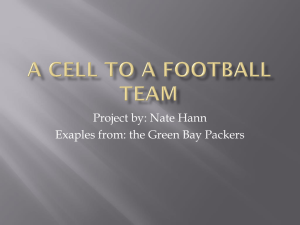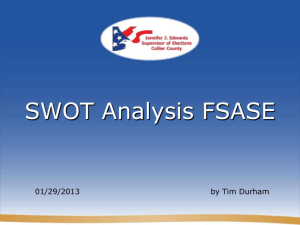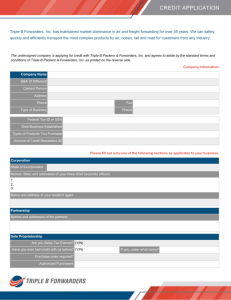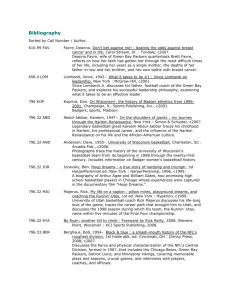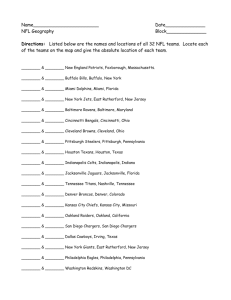The Green Bay Packers are a historical, cultural, and geographical
advertisement
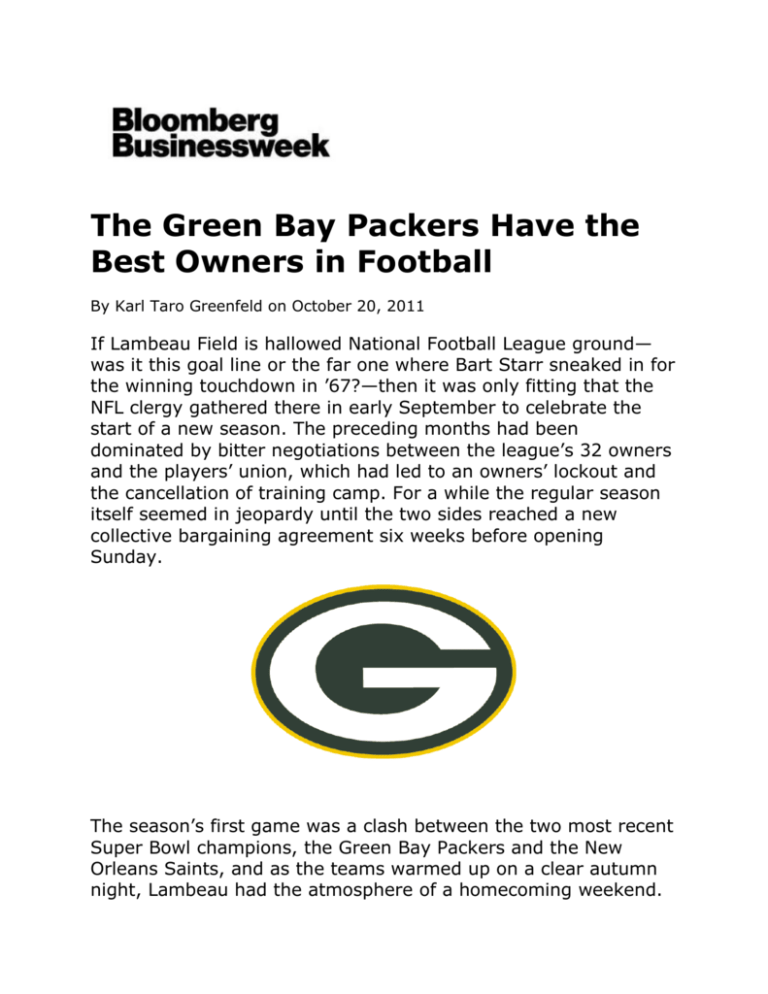
The Green Bay Packers Have the Best Owners in Football By Karl Taro Greenfeld on October 20, 2011 If Lambeau Field is hallowed National Football League ground— was it this goal line or the far one where Bart Starr sneaked in for the winning touchdown in ’67?—then it was only fitting that the NFL clergy gathered there in early September to celebrate the start of a new season. The preceding months had been dominated by bitter negotiations between the league’s 32 owners and the players’ union, which had led to an owners’ lockout and the cancellation of training camp. For a while the regular season itself seemed in jeopardy until the two sides reached a new collective bargaining agreement six weeks before opening Sunday. The season’s first game was a clash between the two most recent Super Bowl champions, the Green Bay Packers and the New Orleans Saints, and as the teams warmed up on a clear autumn night, Lambeau had the atmosphere of a homecoming weekend. There was Starr holding a Green Bay Packer flag, NFL Commissioner Roger Goodell greeting New Orleans Saints coach Sean Payton, and Bob Costas and Tony Dungy doing the NBC pregame show. A few feet away stood a man few casual fans would recognize, but who was nonetheless indispensable to making this night possible: Mark H. Murphy, the Packers’ president and chief executive officer. Murphy is the embodiment of that rags-toriches fable wherein the boy working on the shop floor can grow up to run the whole factory. There have been other former players who owned teams, including Packers’ founder Curly Lambeau, but Murphy is the only player-turned-CEO to win a Super Bowl in both roles, as a player with Washington in 1983 and as Green Bay’s CEO last season. The “Lambeau Leap” Murphy wore a black suit, paisley tie with swirls of green and yellow, charcoal trousers, and five-lace-hole black shoes. He walked along the grass near the white-chalk sideline, with the shambling, slightly stiff-legged shuffle of the ex-athlete. As the Packers completed their drills and gathered in a pregame huddle, Murphy said, “That camaraderie with your teammates, it’s impossible to match that outside the game, anywhere else in life. They should savor it, because the transition from being a player is difficult, really challenging.” Few players in NFL history have made that transition in quite so remarkable a fashion as Murphy. That he is here on this field, the head of the most successful team in America’s most popular sport, speaks volumes not just about him but also about the peculiar genius of the organization that he runs. The Green Bay Packers are a historical, cultural, and geographical anomaly, a publicly traded corporation in a league that doesn’t allow them, an immensely profitable company whose shareholders are forbidden by the corporate bylaws to receive a penny of that profit, a franchise that has flourished despite being in the smallest market in the NFL—with a population of 102,000, it would be small for a Triple A baseball franchise. Of all the original NFL franchises—located in places like Muncie, Ind., Rochester, N.Y., Massillon and Canton, Ohio, and Rock Island, Ill.—Green Bay is the only small-town team still in existence. The Packers have managed not merely to survive but to become the NFL’s dominant organization, named by ESPN in 2011 as the best franchise in all of sports. The “Minister of Defense” The Packers have sold out 295 consecutive home games, and there are 80,000 names on the waiting list for season tickets. Everywhere you look in Green Bay there is Go Pack signage—at the obvious places, like Brett Favre’s Steakhouse just off Holmgren Way, and the less obvious, like the Pho #1 Noodle & Grill on Oneida Street. Green Bay residents consider it a point of pride to buy their own bodyweight annually in Packers paraphernalia. The Packers led the NFL in apparel sales last year—the top two selling jerseys in the league were Packers Aaron Rodgers and Clay Matthews—making $27 million just through the pro shop inside Lambeau Field and the site Packers.com. All that swag, and those endless sellouts, made the Packers the 11th-highest-revenue team in the NFL in 2011, with total income of over $280 million, despite the fact that it plays in by far the smallest of the league’s 32 cities. (Ironically, this success means that Green Bay pays into the NFL reserve fund set up to redistribute revenue from larger market teams to smaller market teams.) When you talk to Packer management, you start to realize that success is a tribute to the careful, constant maintenance of two things: the product on the field and the community’s warm feelings about that product. “It starts with football,” says Murphy. “We structure the organization in a way that we can be successful on the field. But a big part of it is also remembering that this team has a special place in this community. We’re owned by this community. We can’t be perceived as gouging the fans.” The Packers must constantly walk that fine line between profitability and community. Every other NFL franchise is controlled or entirely owned by one majority shareholder, and NFL rules prohibit otherwise. (The Packers’ ownership structure predates current NFL rules.) Ticket prices, concessions, parking, stadium naming rights—all of that is dictated at most NFL stadiums by whatever the owner feels the market will bear, and every additional dollar is profit into the owner’s pockets. A “Cheesehead” The Packers don’t operate like that. Take ticket prices: Even after a 9 percent bump this Super Bowl championship year, the highest-priced ticket is $83, lower than all but two other franchises. In contrast to other NFL venues and their garish, wraparound ad signage, Lambeau is as austere as a high school football stadium. The only ads you see are on the scoreboard; the rest of the stadium has intentionally been maintained so that the vista a fan experiences today is similar to what he would have seen in the ’60s. “We work as hard as anyone to increase revenue, to decrease costs. But we also judge our success by how we are regarded in the community,” says Jason Wied, the team’s vice-president of administration and general counsel. “We could probably double home game revenue if we charged New England Patriot prices, but we have to think of our blue-collar base.” Wied is typical of those near the top of the Packer organization. As a child growing up in Green Bay, he was one of the kids who brought his bike to practice every day in the hopes a player would ride it back to the locker room, a quirky local tradition that cements the bond between community and team. He stayed in Wisconsin for college and law school before coming to work for the Pack. “Our job,” says Wied, “is to sustain this organization into the next generation. To make sure the Packers stay in Green Bay. From time to time we make decisions that may not be in our best interest but are in the best interests of the community.” More often than not, those interests are the same. Although the Packers were founded in 1919 by local high school football star Curly Lambeau, it was the team’s articles of incorporation from 1923, based on a now-defunct Wisconsin nonprofit tax status, that instituted the basic structure. It includes a provision that if the team were sold or moved, the proceeds should go to a local American Legion post. (That was changed in 1997 so the beneficiary would be the Green Bay Packers Foundation, a charitable trust.) Subsequent stock offerings in 1950 and 1997 reauthorized the ownership principles, which would make any modern-day CEO giddy at the operational freedom. The 112,158 Green Bay Packers Inc. shareholders are entitled to no profits or dividends and cannot sell, assign, or transfer a share to a third party. In other words, Packers shares are permanently worthless. “If you’re a Green Bay person, well, you just see this as a way of supporting the team,” says Bea Froelich, 72, who owns two shares, one of which is framed on her stairwell. Owning a share entitles you to show up once a year to approve a slate of directors. Prospective candidates for the board are invited by existing board members, with the nods usually given to prominent local businessmen and community notables. “It’s such an honor when they ask you to join the board,” says Peter M. Platten III, a former vice-president of the Packers and CEO of Valley Bancorporation. “We all grew up here with this team, so when they ask, you feel like you’ve been recognized.” The board in turn elects the executive committee, which makes the important business decisions about running the organization. The biggest is who should be CEO of the Packers—the role that for every other franchise is played by its owner. In 2007 the previous CEO, local businessman Bob Harlan, had hit the mandatory retirement age of 70, and the man scheduled to succeed him, longtime Packers employee John Jones, was forced to step down because of health reasons. For the first time in decades the Packers had no strong internal candidate for CEO. The Packers did what any major corporation would do: They hired an executive search firm, who came up with a candidate most of the team’s directors were unfamiliar with. He was a non-Green Bay resident. Most worryingly, from the standpoint of Packers’ management, their new CEO was a former player who had made his name fighting against the very system he would now be paid to defend. For the complete story, see http://www.businessweek.com/magazine/the-green-bay-packers-have-thebest-owners-in-football-10202011.html (questions on following page) The “Ice Bowl” Closure questions: 1. Who owns the Green Bay Packers? 2. How is this different from other NFL teams? 3. What happens to revenue earned by the franchise? 4. Which of the four P’s do you feel is the primary focus of the Green Bay Packers’ marketing activities? Explain your answer in one well-written paragraph. 5. Give a short description illustrating your perception of their strategy for each of the other P’s. 6. If a corporation such as Cablevision or Time Warner bought the Green Bay Packers, what changes do you think they might bring to the marketing strategy?
